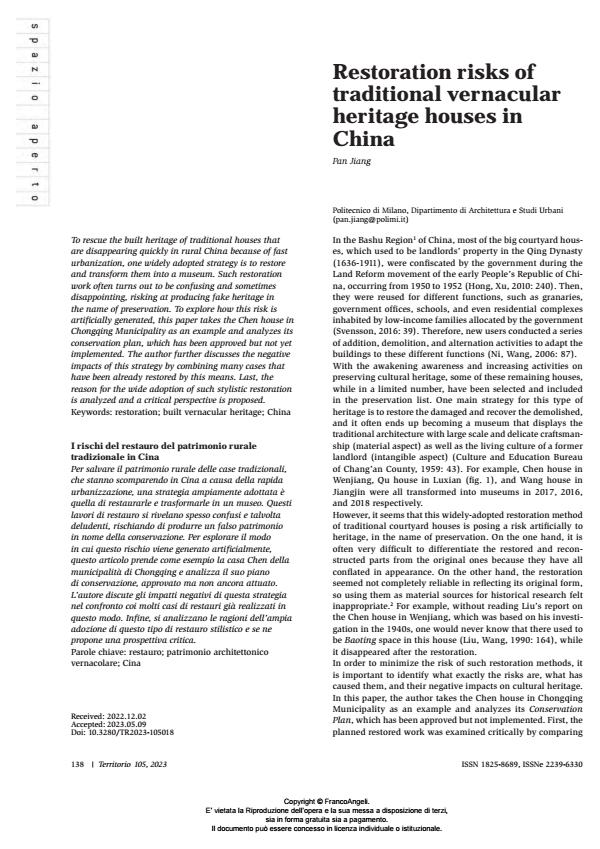Restoration risks of traditional vernacular heritage houses in China
Titolo Rivista TERRITORIO
Autori/Curatori Pan Jiang
Anno di pubblicazione 2024 Fascicolo 2023/105
Lingua Inglese Numero pagine 14 P. 138-151 Dimensione file 773 KB
DOI 10.3280/TR2023-105018
Il DOI è il codice a barre della proprietà intellettuale: per saperne di più
clicca qui
Qui sotto puoi vedere in anteprima la prima pagina di questo articolo.
Se questo articolo ti interessa, lo puoi acquistare (e scaricare in formato pdf) seguendo le facili indicazioni per acquistare il download credit. Acquista Download Credits per scaricare questo Articolo in formato PDF

FrancoAngeli è membro della Publishers International Linking Association, Inc (PILA)associazione indipendente e non profit per facilitare (attraverso i servizi tecnologici implementati da CrossRef.org) l’accesso degli studiosi ai contenuti digitali nelle pubblicazioni professionali e scientifiche
To rescue the built heritage of traditional houses that are disappearing quickly in rural China because of fast urbanization, one widely adopted strategy is to restore and transform them into a museum. Such restoration work often turns out to be confusing and sometimes disappointing, risking at producing fake heritage in the name of preservation. To explore how this risk is artificially generated, this paper takes the Chen house in Chongqing Municipality as an example and analyzes its conservation plan, which has been approved but not yet implemented. The author further discusses the negative impacts of this strategy by combining many cases that have been already restored by this means. Last, the reason for the wide adoption of such stylistic restoration is analyzed and a critical perspective is proposed.
Per salvare il patrimonio rurale delle case tradizionali, che stanno scomparendo in Cina a causa della rapida urbanizzazione, una strategia ampiamente adottata è quella di restaurarle e trasformarle in un museo. Questi lavori di restauro si rivelano spesso confusi e talvolta deludenti, rischiando di produrre un falso patrimonio in nome della conservazione. Per esplorare il modo in cui questo rischio viene generato artificialmente, questo articolo prende come esempio la casa Chen della municipalità di Chongqing e analizza il suo piano di conservazione, approvato ma non ancora attuato. L’autore discute gli impatti negativi di questa strategia nel confronto coi molti casi di restauri già realizzati in questo modo. Infine, si analizzano le ragioni dell’ampia adozione di questo tipo di restauro stilistico e se ne propone una prospettiva critica.
Parole chiave:restauro; patrimonio architettonico vernacolare; Cina
Pan Jiang, Restoration risks of traditional vernacular heritage houses in China in "TERRITORIO" 105/2023, pp 138-151, DOI: 10.3280/TR2023-105018